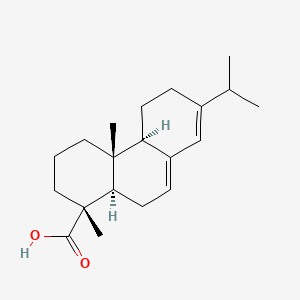| MeSH term | MeSH ID | Detail |
|---|---|---|
| Dermatitis, Contact | D003877 | 59 associated lipids |
| Edema | D004487 | 152 associated lipids |
| Occupational Diseases | D009784 | 42 associated lipids |
| Asthma | D001249 | 52 associated lipids |
| Weight Gain | D015430 | 101 associated lipids |
| Cell Transformation, Neoplastic | D002471 | 126 associated lipids |
| Ulcer | D014456 | 16 associated lipids |
| Psoriasis | D011565 | 47 associated lipids |
Abietic acid
Abietic acid is a lipid of Prenol Lipids (PR) class. Abietic acid is associated with abnormalities such as Hand eczema, Dermatitis, Vitelliform dystrophy, Wiskott-Aldrich Syndrome and Dehydration. The involved functions are known as Process, Oxidation, Anabolism, Transmembrane Transport and physiological aspects. Abietic acid often locates in Membrane, Protoplasm, Microsomes and Cellular Membrane. The associated genes with Abietic acid are SLC33A1 gene and ABCG2 gene. The related lipids are Pinene.
Cross Reference
Introduction
To understand associated biological information of Abietic acid, we collected biological information of abnormalities, associated pathways, cellular/molecular locations, biological functions, related genes/proteins, lipids and common seen animal/experimental models with organized paragraphs from literatures.
What diseases are associated with Abietic acid?
Abietic acid is suspected in Hand eczema, Dermatitis, Dehydration and other diseases in descending order of the highest number of associated sentences.
Related references are mostly published in these journals:
| Disease | Cross reference | Weighted score | Related literature |
|---|
Possible diseases from mapped MeSH terms on references
We collected disease MeSH terms mapped to the references associated with Abietic acid
PubChem Associated disorders and diseases
What pathways are associated with Abietic acid
There are no associated biomedical information in the current reference collection.
PubChem Biomolecular Interactions and Pathways
Link to PubChem Biomolecular Interactions and PathwaysWhat cellular locations are associated with Abietic acid?
Visualization in cellular structure
Associated locations are in red color. Not associated locations are in black.
Related references are published most in these journals:
| Location | Cross reference | Weighted score | Related literatures |
|---|
What functions are associated with Abietic acid?
Related references are published most in these journals:
| Function | Cross reference | Weighted score | Related literatures |
|---|
What lipids are associated with Abietic acid?
Related references are published most in these journals:
| Lipid concept | Cross reference | Weighted score | Related literatures |
|---|
What genes are associated with Abietic acid?
Related references are published most in these journals:
| Gene | Cross reference | Weighted score | Related literatures |
|---|
What common seen animal models are associated with Abietic acid?
There are no associated biomedical information in the current reference collection.
NCBI Entrez Crosslinks
All references with Abietic acid
Download all related citations| Authors | Title | Published | Journal | PubMed Link |
|---|---|---|---|---|
| Gambichler T et al. | Contact dermatitis and other skin conditions in instrumental musicians. | 2004 | BMC Dermatol. | pmid:15090069 |
| Teles M et al. | Anguilla anguilla L. plasma cortisol, lactate and glucose responses to abietic acid, dehydroabietic acid and retene. | 2004 | Environ Int | pmid:14592577 |
| Maria VL et al. | Anguilla anguilla L. genotoxic and liver biotransformation responses to abietic acid exposure. | 2004 | Ecotoxicol. Environ. Saf. | pmid:15157574 |
| Eriksson K et al. | Dermal exposure to terpenic resin acids in Swedish carpentry workshops and sawmills. | 2004 | Ann Occup Hyg | pmid:15059803 |
| Fransman W et al. | Respiratory symptoms and occupational exposures in New Zealand plywood mill workers. | 2003 | Ann Occup Hyg | pmid:12765869 |
| Gigante B et al. | Catechols from abietic acid synthesis and evaluation as bioactive compounds. | 2003 | Bioorg. Med. Chem. | pmid:12659748 |
| Arnó M et al. | Synthesis of C-17-functionalized spongiane diterpenes: diastereoselective synthesis of (-)-spongian-16-oxo-17-al, (-)-acetyldendrillol-1, and (-)-aplyroseol-14. | 2003 | J. Org. Chem. | pmid:12585861 |
| Quinn BP et al. | Selected resin acids in effluent and receiving waters derived from a bleached and unbleached kraft pulp and paper mill. | 2003 | Environ. Toxicol. Chem. | pmid:12503767 |
| Takahashi N et al. | Abietic acid activates peroxisome proliferator-activated receptor-gamma (PPARgamma) in RAW264.7 macrophages and 3T3-L1 adipocytes to regulate gene expression involved in inflammation and lipid metabolism. | 2003 | FEBS Lett. | pmid:12935909 |
| Imaizumi Y et al. | Molecular basis of pimarane compounds as novel activators of large-conductance Ca(2+)-activated K(+) channel alpha-subunit. | 2002 | Mol. Pharmacol. | pmid:12237330 |
